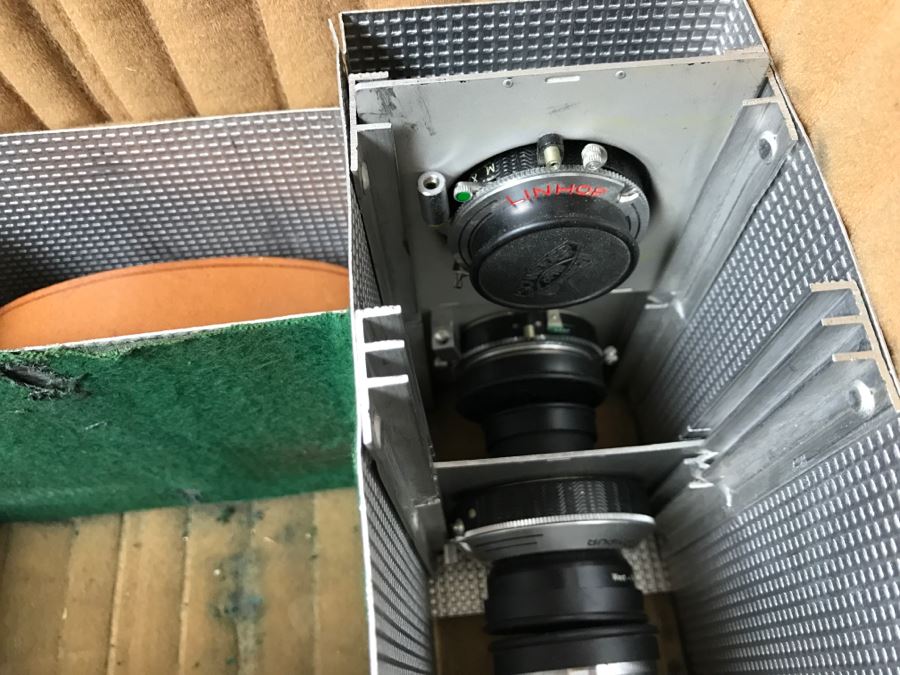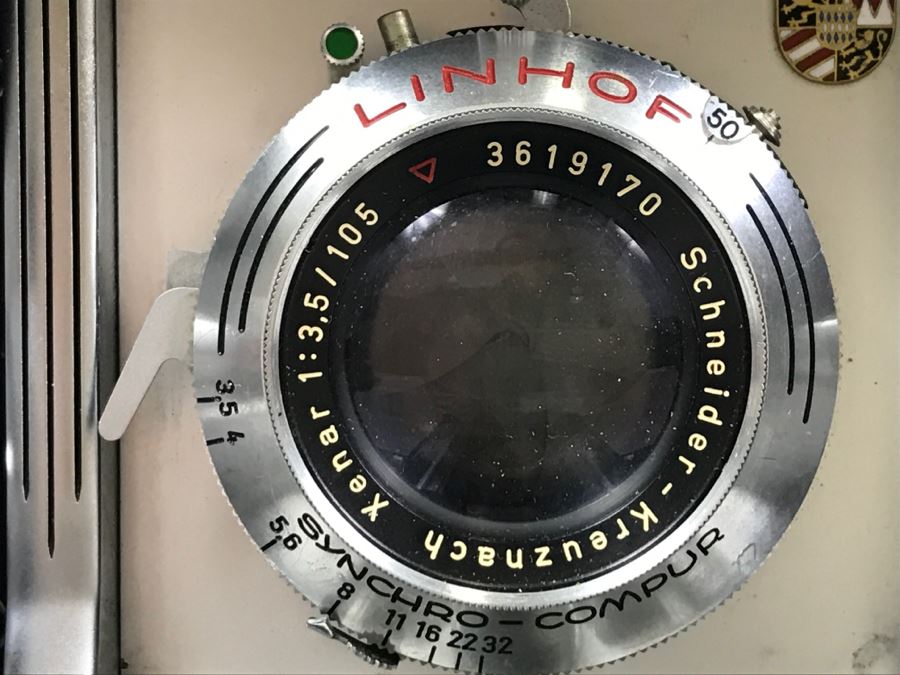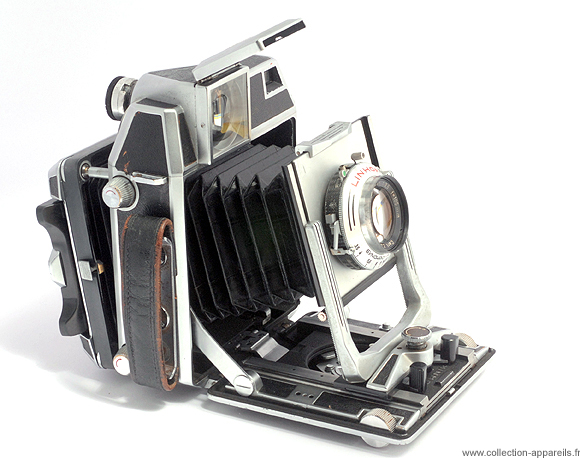Linhof Technorama 612 medium format camera with the original finder, owners certificate and matching serial number sticker. This camera shows normal cosmetic wear as shown above. The finder has some dust specks which don't affect viewing. There was a Linhof certificate (no date) with the camera, but honestly, I don't know if it belongs to this camera. It states that the camera is a Technika III E 4x5, and that the serial number is 55294. The number on the camera's accessory shoe is 72865 and there is no number beneath it (I looked).
– Technika V | Linhof | 1974/75 –

Considering photography as an affair between a light sensitive surface and a lens, that must be held in complete darkness, this camera is a superb darkness provider. Beyond be obviousness of varying the distance in order to get focus, it allows the lens axe to be freely positioned in relation to image plane in translations and angulations. Of course, there are limits for those movements, but lenses have also their range of usability, so we can say that the Technika V, in an incredible array or circumstances, is able to exploit the limits of a great many lenses.
What is also amazing is that the Technika is still in production today (at the time of this post, May/2016). It is probably not senseless to say that the flexibility of its project, first prototype in 1939, is the main reason for that longevity. Today it can take films, as ever, but and also digital backs, new and old lenses and the ones to come will fit in a Technika, and that is what Techkina is all about, making as diverse as possible the combination of a sensitive photographic surface with many, many lenses . It is worthwhile visiting Linhof's website and I recommend you to start from the History pages.
Ready for handheld street photography? Here the Technika is equipped with some add-ons. Lens shade with adapters for different lens diameters and a slot for filters that slip in. Multi focal viewer with paralaxe correction and masks for different film formats. Anatomical grip with cable release. The whole set weights 4 Kg (~9 pounds) and that helps very much in avoiding camera shake when the shutter fires.
Rail allow double extension and remains very solid in this well used 40 years old Technika. Body is in aluminium covered with leather.
Releasing 4 knobs in camera's body you can pull its back and adjust different angles for image plane in relation to lens axe. Lens board can also be tilted vertical an horizontally.
Linhof Technika Serial Number Camera System
For focusing it has a telemeter on the right side for situations when ground glass focusing is impossible. The generous distance between prism and viewer yields good precision.
Coupling of telemeter and focusing knob is provided by blades (the one shown a bit below center in the picture above) that actuate the telemeter according to the lens board position. There are blades for different lenses, the ones sold together by Linhof bear the lens serial number engraved on it. But also, one could send, and that still can be done, lenses to Linhof and they will cut one tailored for a perfect match. In this picture we see a 150 mm with serial number L8491215. I assume any 150mm will do with good enough precision, lenses can't be that different having the same foci, but I never tested.
It is always a good start for a lens to be in the infinity position when you open up your camera. For that, you can set pairs of stops for your different focal lengths directly on the rail. The ones showing a red mark will let the lens board pass over. The other ones, more on the back, are lifted to stop the lens at the desired position. There are also sliding scales for focusing according to the distance. There is a white one on the upper left corner for a 90 mm lens.
Landscape or portrait can be switched without taking the camera out of tripod head. Avatar hacked games. Simply turn the square back and there you are.
Nice accessory to have is a 120 film adapter. It replaces the ground glass and it is very easy to put and take it off. This one makes 5,5 x 7,5 cm frames.
Some lenses, like this Schneider 65 mm, are so short in focus that you can't pull them out of the camera body. For that you may use a special lens board with bellows and adjust focus on the big knob that is positioned right above the lens. To avoid including the drop bed in the picture, specially in portrait position, there is an extra stop for the bed, that opens it up enough for wide angle photography.
Last but not least, it all fit in a nice alluminium case. I bought this set in 1999 and had a lot of fun taking pictures with it.

| Linhof Super Technika III image by Dries van den Elzen(Image rights) |

Linhof is credited with introducing the first all-metal technical field camera. Today the company is known as Linhof Präzisions Systemtechnik GmbH. The company is located in Münich, Germany.
The Technikas are heavy, ruggedly-built cameras with technical possibilities not easily found on other cameras. For example, they offer a limited amount of view camera movements, allowing for perspective corrections. This rather large camera folds up to a self-contained package, thus protecting the lens. High quality large format lenses, made by renowned producers, can be used on the Technikas. Some have been engraved by Linhof, indicating they are up to their standards (and raising their price). For the super Technikas, a rangefinder cam, engraved with the serial number of the lens, couples the rangefinder to the lens-to-film-distance. This allows for rangefinder focusing and thus, handheld shooting.
Kumpulan Serial Number Idm
The Linhof Technika III is a technical field camera for 5x7 inch (13x18cm), 4x5 inch (9x12cm) or 6x9 (2x3inch). This means there are two varieties that operate similarly, but that vary considerably in size. The presence of a coupled rangefinder makes a 'Super Technika' of an ordinary Technika. The Technika IV represents a small next step in the evolution of the Technika cameras with some incremental improvements. Even today, a Technika variation is being produced by Linhof; the Master Technika. The Master Technika is very similar to the Technika III, but some important improvements have been made and most parts are not interchangeable. Linhof's website advocates the Technika series as being most suitable for handheld use.
Links

Considering photography as an affair between a light sensitive surface and a lens, that must be held in complete darkness, this camera is a superb darkness provider. Beyond be obviousness of varying the distance in order to get focus, it allows the lens axe to be freely positioned in relation to image plane in translations and angulations. Of course, there are limits for those movements, but lenses have also their range of usability, so we can say that the Technika V, in an incredible array or circumstances, is able to exploit the limits of a great many lenses.
What is also amazing is that the Technika is still in production today (at the time of this post, May/2016). It is probably not senseless to say that the flexibility of its project, first prototype in 1939, is the main reason for that longevity. Today it can take films, as ever, but and also digital backs, new and old lenses and the ones to come will fit in a Technika, and that is what Techkina is all about, making as diverse as possible the combination of a sensitive photographic surface with many, many lenses . It is worthwhile visiting Linhof's website and I recommend you to start from the History pages.
Ready for handheld street photography? Here the Technika is equipped with some add-ons. Lens shade with adapters for different lens diameters and a slot for filters that slip in. Multi focal viewer with paralaxe correction and masks for different film formats. Anatomical grip with cable release. The whole set weights 4 Kg (~9 pounds) and that helps very much in avoiding camera shake when the shutter fires.
Rail allow double extension and remains very solid in this well used 40 years old Technika. Body is in aluminium covered with leather.
Releasing 4 knobs in camera's body you can pull its back and adjust different angles for image plane in relation to lens axe. Lens board can also be tilted vertical an horizontally.
Linhof Technika Serial Number Camera System
For focusing it has a telemeter on the right side for situations when ground glass focusing is impossible. The generous distance between prism and viewer yields good precision.
Coupling of telemeter and focusing knob is provided by blades (the one shown a bit below center in the picture above) that actuate the telemeter according to the lens board position. There are blades for different lenses, the ones sold together by Linhof bear the lens serial number engraved on it. But also, one could send, and that still can be done, lenses to Linhof and they will cut one tailored for a perfect match. In this picture we see a 150 mm with serial number L8491215. I assume any 150mm will do with good enough precision, lenses can't be that different having the same foci, but I never tested.
It is always a good start for a lens to be in the infinity position when you open up your camera. For that, you can set pairs of stops for your different focal lengths directly on the rail. The ones showing a red mark will let the lens board pass over. The other ones, more on the back, are lifted to stop the lens at the desired position. There are also sliding scales for focusing according to the distance. There is a white one on the upper left corner for a 90 mm lens.
Landscape or portrait can be switched without taking the camera out of tripod head. Avatar hacked games. Simply turn the square back and there you are.
Nice accessory to have is a 120 film adapter. It replaces the ground glass and it is very easy to put and take it off. This one makes 5,5 x 7,5 cm frames.
Some lenses, like this Schneider 65 mm, are so short in focus that you can't pull them out of the camera body. For that you may use a special lens board with bellows and adjust focus on the big knob that is positioned right above the lens. To avoid including the drop bed in the picture, specially in portrait position, there is an extra stop for the bed, that opens it up enough for wide angle photography.
Last but not least, it all fit in a nice alluminium case. I bought this set in 1999 and had a lot of fun taking pictures with it.
| Linhof Super Technika III image by Dries van den Elzen(Image rights) |
Linhof is credited with introducing the first all-metal technical field camera. Today the company is known as Linhof Präzisions Systemtechnik GmbH. The company is located in Münich, Germany.
The Technikas are heavy, ruggedly-built cameras with technical possibilities not easily found on other cameras. For example, they offer a limited amount of view camera movements, allowing for perspective corrections. This rather large camera folds up to a self-contained package, thus protecting the lens. High quality large format lenses, made by renowned producers, can be used on the Technikas. Some have been engraved by Linhof, indicating they are up to their standards (and raising their price). For the super Technikas, a rangefinder cam, engraved with the serial number of the lens, couples the rangefinder to the lens-to-film-distance. This allows for rangefinder focusing and thus, handheld shooting.
Kumpulan Serial Number Idm
The Linhof Technika III is a technical field camera for 5x7 inch (13x18cm), 4x5 inch (9x12cm) or 6x9 (2x3inch). This means there are two varieties that operate similarly, but that vary considerably in size. The presence of a coupled rangefinder makes a 'Super Technika' of an ordinary Technika. The Technika IV represents a small next step in the evolution of the Technika cameras with some incremental improvements. Even today, a Technika variation is being produced by Linhof; the Master Technika. The Master Technika is very similar to the Technika III, but some important improvements have been made and most parts are not interchangeable. Linhof's website advocates the Technika series as being most suitable for handheld use.
